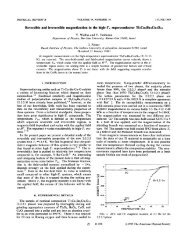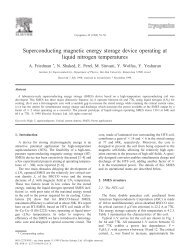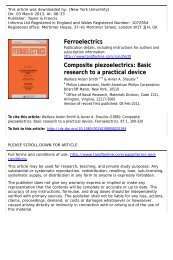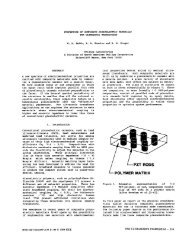Sonochemical synthesis of nanocrystalline LaFeO 3 - ResearchGate
Sonochemical synthesis of nanocrystalline LaFeO 3 - ResearchGate
Sonochemical synthesis of nanocrystalline LaFeO 3 - ResearchGate
Create successful ePaper yourself
Turn your PDF publications into a flip-book with our unique Google optimized e-Paper software.
(specifically, amorphous Fe 2 O 3 ) also contributes to the<br />
lowering <strong>of</strong> calcination temperature. It can be seen from the<br />
work <strong>of</strong> Vazquez-Vazquez et al. 24 that by using conventional<br />
lanthanum and iron nitrates, the mean particle size <strong>of</strong> the<br />
ferrite obtained is about 120 nm, at a calcination temperature<br />
<strong>of</strong> 800 uC. In addition, formation <strong>of</strong> the secondary phases <strong>of</strong><br />
La(OH) 3 , a-Fe 2 O 3 and ferrihydrite have also been noted at this<br />
temperature. It has also been found that a temperature <strong>of</strong><br />
1000 uC for 184 h is necessary to obtain pure and wellcrystallized<br />
<strong>LaFeO</strong> 3 . However, in the present case, by applying<br />
a calcination temperature <strong>of</strong> 800 uC for 24 h, the mean particle<br />
size <strong>of</strong> the obtained ferrite is 30 nm and no secondary phases<br />
are observed, which might be due to the highly reactive<br />
amorphous Fe 2 O 3 generated by ultrasound already present in<br />
the system.<br />
Fig. 7 The magnetization vs. applied field (measured at room temperature)<br />
pattern for the ultrafine <strong>LaFeO</strong> 3 system prepared by a<br />
sonochemical technique followed by calcination at 800 uC in air for 24 h.<br />
<strong>LaFeO</strong> 3 at room temperature using a vibrating sample<br />
magnetometer (VSM). From the hysteresis plot, we can<br />
observe hysteresis but no clear saturation <strong>of</strong> magnetization<br />
within the field limit <strong>of</strong> y16000 Oe. Normally, the <strong>LaFeO</strong> 3<br />
system is either weakly ferromagnetic (WFM) or antiferromagnetic<br />
(AFM) with a Néel temperature T N y 477 uC. 30 For<br />
a 30 nm <strong>LaFeO</strong> 3 particle size system, Qi et al. 31 reported a<br />
coercive field <strong>of</strong> y90 G and a saturation magnetization M s <strong>of</strong><br />
y2.75 emu g 21 at room temperature. In our case, the<br />
corresponding values are y250 Oe and y40 memu g 21 ,<br />
respectively. This reflects a further increase in the magnetocrystalline<br />
anisotropy, which is expected in the <strong>nanocrystalline</strong><br />
system. The squareness ratio M r /M s in our case is y0.055,<br />
which is quite small, compared to the value (y0.135)<br />
reported. 31 All these results point out to the presence <strong>of</strong> a<br />
large number <strong>of</strong> fine particles in our system. The average<br />
particle size <strong>of</strong> our system is y30 nm.<br />
In the conventional solid-state reaction <strong>of</strong> Fe 2 O 3 with<br />
lanthanum carbonate to form the lanthanum ferrite, the<br />
major limitation is the diffusion factor. In the present<br />
sonochemical method this diffusion resistance may be overcome,<br />
as there is an in situ generation <strong>of</strong> amorphous Fe 2 O 3<br />
from Fe(CO) 5 by ultrasound, followed by its dispersion or<br />
deposition on lanthanum carbonate, again assisted by ultrasound.<br />
This process might facilitate the diffusion, as well as the<br />
reaction, <strong>of</strong> highly reactive lanthanum ion (La 31 ) with the<br />
amorphous Fe 2 O 3 , resulting in the completion <strong>of</strong> the phase<br />
transition <strong>of</strong> the precursor to the <strong>LaFeO</strong> 3 ferrite at a lower<br />
calcination temperature <strong>of</strong> 800 uC, employed in the present<br />
method.<br />
The amorphous nature <strong>of</strong> Fe 2 O 3 synthesized by ultrasound<br />
might also play a key role in increasing its reactivity with<br />
lanthanum carbonate, resulting in the formation <strong>of</strong> a ferrite<br />
phase at the lower calcination temperature. The importance <strong>of</strong><br />
amorphicity in increasing the reactivity has already been<br />
discussed. 32 Bellisent et al. 21 have clearly shown that sonochemically<br />
prepared amorphous Fe, Co and Fe–CO nanomaterials<br />
are better catalysts than the corresponding crystalline<br />
nanomaterials prepared by other methods. In addition, Yee<br />
et al. 33 have functionalized amorphous Fe 2 O 3 nanoparticles<br />
with alkanesulfonic and octadecanephosphonic acids. This<br />
work further supports the fact that it is possible to form a<br />
coating <strong>of</strong> organic molecules more easily on amorphous Fe 2 O 3 .<br />
In addition to the above factors, the size <strong>of</strong> the reactants<br />
Conclusions<br />
In the present investigation, <strong>LaFeO</strong> 3 has been synthesized from<br />
lanthanum carbonate and iron pentacarbonyl via a sonochemical<br />
method for the first time. The sonochemically synthesized<br />
<strong>LaFeO</strong> 3 is a <strong>nanocrystalline</strong> material with high purity and good<br />
homogeneity. It was obtained with lower processing temperatures<br />
and shorter annealing times. The obtained nan<strong>of</strong>errite<br />
powder is expected to be used in applications for functional<br />
ceramics (sensors, SOFCs, electrodes, or even magnetic and<br />
ferroelectric applications).<br />
Acknowledgements<br />
We thank The Ministry <strong>of</strong> Science, Sport and Culture for a<br />
Materials Science grant through the Sino–Israeli program in<br />
Materials Science. We also thank Ms Louise Braverman for<br />
editorial assistance.<br />
References<br />
1 M. L. Lau, H. G. Jiang, R. J. Perez, J. Juarezislas and<br />
E. J. Lavernia, Nanostruct. Mater., 1996, 7, 847.<br />
2 N. Q. Minh, J. Am. Ceram. Soc., 1993, 76, 563.<br />
3 A. Delmastro, D. Mazza, S. Ronchetti, M. Vallino, R. Spinicci,<br />
P. Brovetto and M. Salis, Mater. Sci. Eng. B, 2001, 79, 140.<br />
4 S. L. Bai, X. X. Fu, J. Z. Wang, Q. H. Yang, Y. H. Sun and<br />
S. L. Zeng, Chin. J. Appl. Chem., 2000, 17, 343.<br />
5 Q. Ming, M. D. Nersesyan, A. Wagner, J. Ritchie,<br />
J. T. Richardson, D. Luss, A. J. Jacobson and Y. L. Yang,<br />
Solid State Ionics, 1999, 122, 113.<br />
6 T. Arakawa, H. Kurachi and J. Shiokawa, J. Mater. Sci., 1985, 20,<br />
1207.<br />
7 Y. Shimizu, M. Shimabukuro, H. Arai and T. Seiyama, Chem.<br />
Lett., 1985, 163, 917.<br />
8 G. Martinelli, M. C. Carotta, M. Ferroni, Y. Sadaoka and<br />
E. Traversa, Sens. Actuators B, 1999, 55, 99.<br />
9 B. I. Ita, Ph.D Thesis, University <strong>of</strong> Calabar, Nigeria, 1998.<br />
10 W. J. Zheng, R. H. Liu, D. K. Peng and G. Y. Meng, Mater. Lett.,<br />
2000, 43, 19.<br />
11 S. S. Manoharan and K. C. Patil, J. Solid State Chem., 1993, 102,<br />
267.<br />
12 A. Chakraborty, P. S. Devi and H. S. Maiti, J. Mater. Res., 1995,<br />
10, 918.<br />
13 J. Xiao, G. Y. Hong, D. C. Yu, X. T. Dong, D. J. Wang, L. Jiang<br />
and T. J. Li, Acta Chim. Sin., 1994, 52, 784.<br />
14 N. Pandya, R. G. Kulkarni and P. H. Parsania, Mater. Res. Bull.,<br />
1990, 25, 1073.<br />
15 X. Li, H. B. Zhang and M. Y. Zhao, Mater. Chem. Phys., 1994, 37,<br />
132.<br />
16 P. Ravindranathan, S. Komarneni and R. Roy, J. Mater. Sci.<br />
Lett., 1993, 12, 369.<br />
17 B. I. Ita, U. J. Ekpe and U. J. Ibok, Global J. Pure Appl. Chem.,in<br />
press.<br />
18 P. Jeevanandam, Y. Koltypin, O. Palchik and A. Gedanken,<br />
J. Mater. Chem., 2001, 11, 869.<br />
19 K. S. Suslick, S. B. Choe, A. A. Cichowlas and M. W. Grinstaff,<br />
Nature, 1991, 353, 414.<br />
768 J. Mater. Chem., 2004, 14, 764–769








